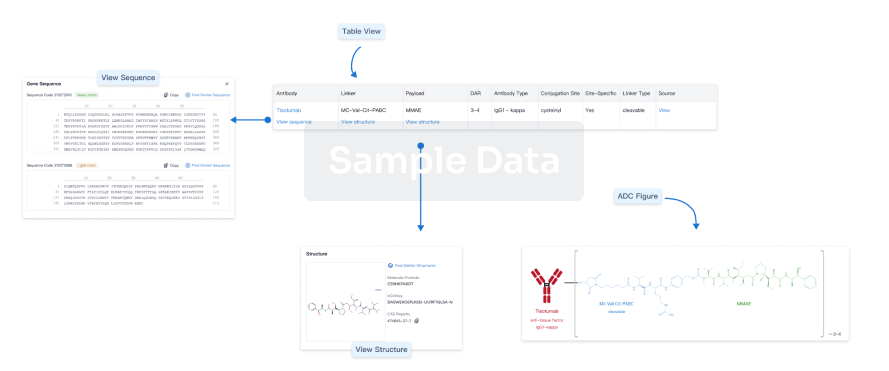Request Demo
Last update 08 May 2025
Capromab Pendetide
Last update 08 May 2025
Overview
Basic Info
Drug Type Radiolabeled antibody, Diagnostic radiopharmaceuticals |
Synonyms (111In)-Capromab pendetide, Capromab, Indium (111In) capromab pendetide + [11] |
Target |
Action inhibitors |
Mechanism PSMA inhibitors(Prostate-specific membrane antigen inhibitors) |
Therapeutic Areas |
Active Indication |
Inactive Indication- |
Originator Organization |
Active Organization |
Inactive Organization- |
License Organization- |
Drug Highest PhaseApproved |
First Approval Date United States (28 Oct 1996), |
Regulation- |
Login to view timeline
Structure/Sequence
Boost your research with our ADC technology data.
login
or

Related
1
Clinical Trials associated with Capromab PendetideNCT00562315
18F-FACBC PET-CT for the Detection and Staging of Recurrent Prostate Carcinoma (CA129356-01).
Hypothesis:Anti-[18F]FACBC PET-CT will adequately detect local and extraprostatic recurrence, and lead to better characterization of disease status in restaging patients.
This is a study that will test a compound (chemical substance) that has a small amount of radioactivity attached to it. This substance has a natural tendency to go to prostate tissue. The substance is called [18]FACBC and it is given in the form of an injection into a vein. After the substance reaches the prostate, scans called PET or Positron Emission Tomography, are done. This is similar to having CAT scans or x-rays. Usually a compound called [18]FDG is used for PET scans but this substance is eliminated by the kidneys and cannot reach the prostate. This substance called [18]FACBC is not eliminated by the kidneys and may allow tumors in the prostate to be seen better. It is sometimes difficult to tell if a growth on the prostate is cancer with scans or x-rays that are usually done.
Anti-[18F]FACBC PET-CT will be compared to ProstaScint (In-capromab pendetide) which is the conventional imaging for prostate cancer. Investigators will be blinded of the intervention.
This study will look at how the [18]FACBC goes into the prostate tissue and determine its ability to detect recurrent prostate cancer.
This is a study that will test a compound (chemical substance) that has a small amount of radioactivity attached to it. This substance has a natural tendency to go to prostate tissue. The substance is called [18]FACBC and it is given in the form of an injection into a vein. After the substance reaches the prostate, scans called PET or Positron Emission Tomography, are done. This is similar to having CAT scans or x-rays. Usually a compound called [18]FDG is used for PET scans but this substance is eliminated by the kidneys and cannot reach the prostate. This substance called [18]FACBC is not eliminated by the kidneys and may allow tumors in the prostate to be seen better. It is sometimes difficult to tell if a growth on the prostate is cancer with scans or x-rays that are usually done.
Anti-[18F]FACBC PET-CT will be compared to ProstaScint (In-capromab pendetide) which is the conventional imaging for prostate cancer. Investigators will be blinded of the intervention.
This study will look at how the [18]FACBC goes into the prostate tissue and determine its ability to detect recurrent prostate cancer.
Start Date01 Oct 2007 |
Sponsor / Collaborator  Emory University Emory University [+1] |
100 Clinical Results associated with Capromab Pendetide
Login to view more data
100 Translational Medicine associated with Capromab Pendetide
Login to view more data
100 Patents (Medical) associated with Capromab Pendetide
Login to view more data
74
Literatures (Medical) associated with Capromab Pendetide01 Apr 2020·Journal of Nuclear MedicineQ1 · MEDICINE
Appropriate Use Criteria for Imaging Evaluation of Biochemical Recurrence of Prostate Cancer After Definitive Primary Treatment
Q1 · MEDICINE
Article
Author: Subramaniam, Rathan M ; Oldan, Jorge D ; Ahuja, Sukhjeet ; Pomper, Martin G ; Klitzke, Alan K ; Choyke, Peter L ; Taneja, Samir S ; Fanti, Stefano ; Herrmann, Ken ; Gulley, James L ; Hope, Thomas A ; Vargas, Herbert Alberto ; Jadvar, Hossein ; Rowe, Steven P ; Ballas, Leslie K
01 Aug 2019·Cancer Reports
Comparison of prostate‐specific membrane antigen ligands in clinical translation research for diagnosis of prostate cancer
Review
Author: Chelvam, Venkatesh ; Asha Krishnan, Mena ; Sengupta, Sagnik ; Chattopadhyay, Sudeshna
01 Oct 2015·Nuclear Medicine and BiologyQ4 · MEDICINE
A high-affinity [18F]-labeled phosphoramidate peptidomimetic PSMA-targeted inhibitor for PET imaging of prostate cancer
Q4 · MEDICINE
Article
Author: Murphy, Stephanie ; Berkman, Clifford E ; Barinka, Cyril ; Drake, Christopher R ; Dannoon, Shorouk ; Ganguly, Tanushree ; Jivan, Salma ; Blecha, Joseph E ; Jones, Ella F ; Hopkins, Mark R ; Cahaya, Hendry ; VanBrocklin, Henry F
1
News (Medical) associated with Capromab Pendetide16 Apr 2010
Our CEO was recently interviewed by Mr. Bob Crimmons, co-founder of iMedExchange, a social networking site for physicians and is reproduced below. The interview was put on the iMedExcahnge website as a blog for further comment and can be found at iMedExchange.
"As a man approaching middle age, I have to say I listened to Beatrice Langton-Webster, CEO of Cancer Targeted Technology (CTT), with a little extra interest. CTT is developing a PET imaging agent that helps diagnose and monitor early and late-stage cancers; their first product, CTT-1057, is aimed at prostate cancer. Incorporated in 2005, with initial patent filings, CTT became fully operational in 2009 when Dr. Langton-Webster took the helm, bringing 25 years of experience in pharmaceutical drug development and commercialization. I asked Bea to share some of the challenges facing early stage pharma companies and what is in store for the future of CTT.
With a little over 5 years of development, clinical trials and FDA approval , CTT has a lot of work ahead but in reality this timing is rapid for this type of diagnostic agent due in part to similarities with another product currently on the market. Bea stated "it is important for Pharmas and Biotechs to understand not only what makes their products better than their competitors, but also what the patient and physician really need and will use." Bea is excited about CTT1057 due to significant benefits it has over existing agents. According to Bea, "CTT1057 targets an important molecular marker in prostate cancer, and will have important advantages over the marketed imaging agent, Prostascint, and other agents in development, including the ability to specifically image abdominal and distal bone disease, the ability to collect better resolution images and the ability to image smaller tumor lesions. For the physician it is important that we develop an agent that has the capabilities to specifically detect minimal disease in multiple locations. For the patient, it is important that we develop a diagnostic with time and cost convenience. We will be able to provide CTT-54 images within a couple of hours with better overall diagnostic accuracy , no associated toxicity and at a cost that is lower than our competitors".
A critical challenge for CTT, at this stage, is understanding how physicians would use this new diagnostic agent. For example, CTT1057 would allow physicians to relatively quickly, easily and safely monitor metastatic disease and the effectiveness of cancer treatment in ways that are not practicable today; whether this new capability would be embraced by physicians and what physicians would need to support it are questions CTT would like to ask physicians.
Relatively speaking, CTT is on a fast track to commercialization but there is still a lot of work to be done, including clinical trials, FDA approval... and some more fund raising. Physicians will play a vital role in all aspects of this work, from product development to monotoring clinical trials and FDA advocacy. Physicians even play an important critical role in fund raising by supporting CTT's market validation claims with venture capital firms and potential strategic partners.
CTT is a paradigm example of the life sciences innovation coming out of iMedExchange's own back yard and we'll watch with interest as Bea shepherds the company through the next phases of the process."
100 Deals associated with Capromab Pendetide
Login to view more data
External Link
| KEGG | Wiki | ATC | Drug Bank |
|---|---|---|---|
| D04525 | Capromab Pendetide |
R&D Status
10 top approved records. to view more data
Login
| Indication | Country/Location | Organization | Date |
|---|---|---|---|
| Neoplasm Metastasis | United States | 28 Oct 1996 | |
| Prostatic Cancer | United States | 28 Oct 1996 |
Login to view more data
Clinical Result
Clinical Result
Indication
Phase
Evaluation
View All Results
| Study | Phase | Population | Analyzed Enrollment | Group | Results | Evaluation | Publication Date |
|---|
No Data | |||||||
Login to view more data
Translational Medicine
Boost your research with our translational medicine data.
login
or

Deal
Boost your decision using our deal data.
login
or

Core Patent
Boost your research with our Core Patent data.
login
or

Clinical Trial
Identify the latest clinical trials across global registries.
login
or

Approval
Accelerate your research with the latest regulatory approval information.
login
or

Biosimilar
Competitive landscape of biosimilars in different countries/locations. Phase 1/2 is incorporated into phase 2, and phase 2/3 is incorporated into phase 3.
login
or

Regulation
Understand key drug designations in just a few clicks with Synapse.
login
or

AI Agents Built for Biopharma Breakthroughs
Accelerate discovery. Empower decisions. Transform outcomes.
Get started for free today!
Accelerate Strategic R&D decision making with Synapse, PatSnap’s AI-powered Connected Innovation Intelligence Platform Built for Life Sciences Professionals.
Start your data trial now!
Synapse data is also accessible to external entities via APIs or data packages. Empower better decisions with the latest in pharmaceutical intelligence.
Bio
Bio Sequences Search & Analysis
Sign up for free
Chemical
Chemical Structures Search & Analysis
Sign up for free
